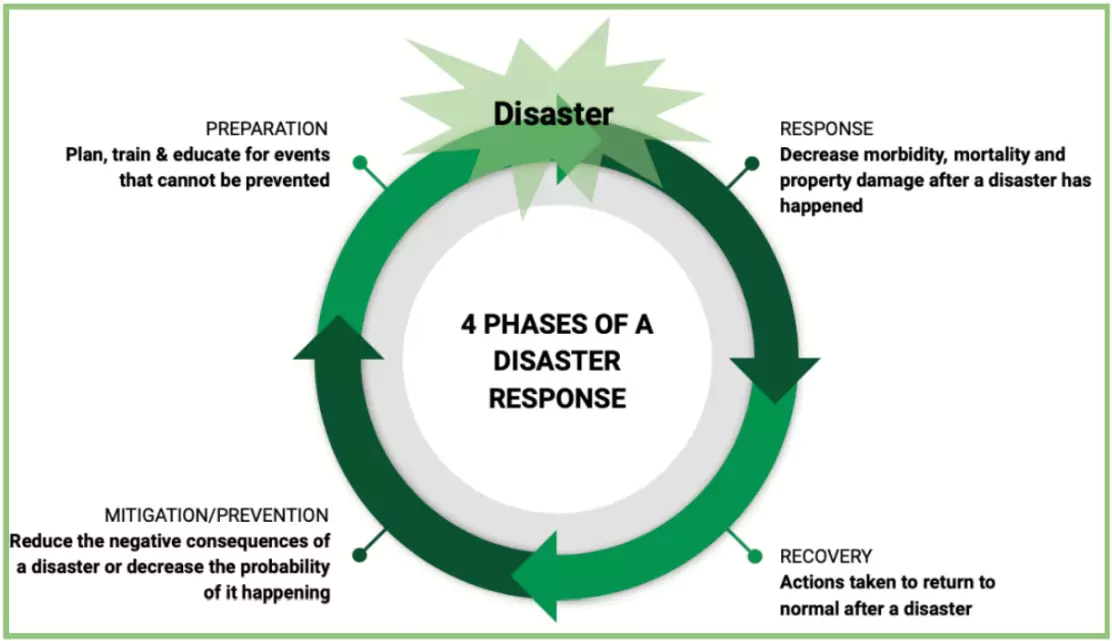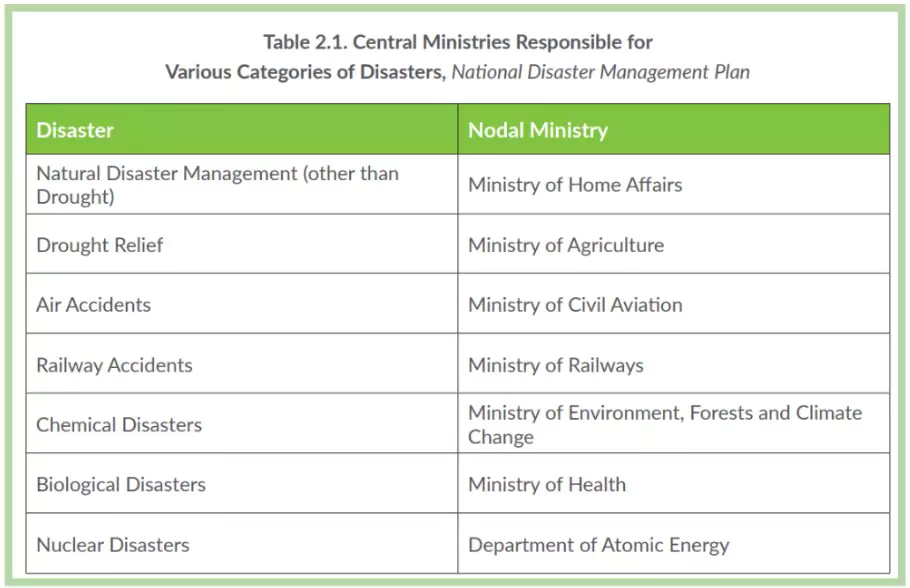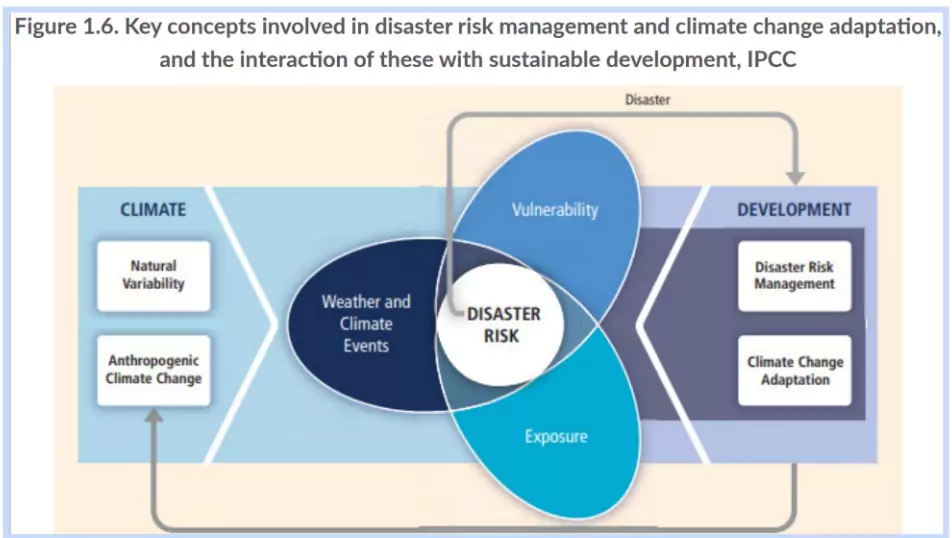Darjeeling, West Bengal has recently faced devastating landslides and floods due to extreme rainfall.
- This highlights the region’s vulnerability to climate-induced disasters and the need for disaster resilience.
About Disaster Resilience
- Disaster resilience is about anticipating, planning and reducing disaster risk to effectively protect persons, communities and countries, their livelihoods, health, cultural heritage, socio-economic assets and ecosystems.
- The ideas of ‘bounce back’, ‘spring forward’ and ‘build back better’ are often used in the context of resilience.
- “Bounce Back” refers to the capacity of individuals, communities, and systems to recover from disasters quickly, restoring essential functions, services, and livelihoods to pre-disaster levels.
- “Spring Forward” is the capacity not just to recover but to adapt and improve one’s ability to withstand future disasters, making systems more flexible and forward-looking.
- “Build Back Better” is a concept promoted by the United Nations Office for Disaster Risk Reduction (UNDRR), focusing on reconstruction after disasters in a way that enhances resilience, reduces vulnerability, and strengthens sustainable development.
Key Characteristics of Disaster Resilience

- Comprehensive Preparedness: Disaster resilience requires meticulous planning for diverse scenarios, including natural hazards like cyclones, floods, earthquakes, and human-induced disasters such as industrial accidents.
- Robust Institutional Support: Resilient systems rely on strong institutional frameworks for coordination and decision-making. In India, the National Disaster Management Authority (NDMA) serves as the apex body for planning, policy-making, and coordinating disaster risk reduction (DRR) at national, state, and district levels.
- Integration with Sustainable Development: Disaster resilience must align with long-term sustainability goals.
- Legislative Backbone: Effective laws and policies institutionalize disaster preparedness. India’s Disaster Management Act, 2005 defines roles and responsibilities for government agencies, enabling a structured approach to mitigation, preparedness, response, and recovery.
- Technological Advancements in Early Warning: Modern technologies like satellite monitoring, remote sensing, Geographic Information System (GIS)-based risk mapping, and predictive modeling enhance early warning capabilities.
- Educational Programs and Public Awareness: Public education fosters a culture of preparedness.
Determinants of Disaster Resilience
- Risk Identification through Comprehensive Assessments: Understanding hazards, vulnerabilities, and potential impacts is essential.
- India’s Hazard Identification and Risk Assessment (HIRA) process systematically evaluates risks across regions, enabling targeted mitigation strategies.
- Community-Centric Evaluation Measures: Resilience strengthens when communities actively participate in planning. Local knowledge helps identify vulnerabilities and tailor interventions.
- For example, village-level disaster committees under the National Landslide Risk Mitigation Project (NLRMP) ensure that mitigation measures address real local challenges.
- Resource Allocation for Emergency Preparedness: Adequate allocation of financial, human, and technological resources is critical.
- India’s National Disaster Mitigation Fund (NDMF) provides states and union territories with funding for preparedness, mitigation, and recovery projects.
- Policy Implementation and Infrastructure Robustness: Strong policies and resilient infrastructure reduce disaster impacts.
- Japan’s seismic-resistant buildings and India’s cyclone-resilient housing in Odisha and Andhra Pradesh exemplify how robust construction norms save lives and protect property.
- Adaptation to Emerging Challenges: Resilience requires flexibility to address emerging threats like climate change, urban flooding, and glacial lake outbursts.
- Innovative solutions like flood reservoirs, coastal mangrove restoration, and climate-adaptive agriculture enhance adaptive capacity.
- Recovery and Rehabilitation Capabilities: Effective post-disaster recovery ensures long-term resilience.
- Recovery efforts after Hurricane Katrina (2005) in the United States highlighted the importance of long-term rehabilitation strategies.
- India’s Smritivan Memorial in Bhuj symbolizes remembrance and learning from the 2001 earthquake to guide future resilience measures.
Need for Disaster Resilience in India
- India as a Multi-Hazard Prone Country: India, being a multi-hazard prone country, faces frequent and diverse natural disasters including earthquakes, floods, cyclones, landslides, heatwaves, and glacial lake outburst floods (GLOFs).
- Vulnerability Statistics: According to the National Disaster Management Authority (NDMA), approximately 58% of districts are vulnerable to seismic hazards, 12% are prone to cyclones, and 75% face droughts.
- Impact of Climate Change: The intensification of climate change has further increased the frequency, severity, and unpredictability of these hazards, posing a significant threat to lives, livelihoods, critical infrastructure, and the national economy.
- Socio-Economic Consequences of Disasters:
 Loss of Lives and Health Risks: Increased mortality and secondary effects such as disease and malnutrition.
Loss of Lives and Health Risks: Increased mortality and secondary effects such as disease and malnutrition.- Disruption of Livelihoods: Particularly in agriculture, fisheries, and informal sectors.
- Damage to Critical Infrastructure: Includes roads, bridges, schools, and hospitals.
- Economic Losses: Disasters cause significant setbacks to regional and national GDP.
- Forced Migration and Displacement: Adding pressure on urban centers.
- Equity Implications: Disproportionate impact on vulnerable and marginalized communities, emphasizing the social equity dimension of disaster resilience.
- These challenges illustrate that disasters are not merely natural events, but socio-economic stress multipliers, affecting communities, infrastructure, and development.
India’s Comprehensive Disaster Risk Reduction Initiatives
- India has adopted a holistic approach spanning prevention, preparedness, response, mitigation, recovery, and reconstruction.
- Institutional and Policy Framework: The Ministry of Home Affairs (MHA) and the National Disaster Management Authority (NDMA) oversee both pre-disaster preparedness and post-disaster response. Key institutional mechanisms include:
- National Disaster Management Plan (NDMP): First developed in 2016 and revised in 2019, aligned with the Sendai Framework, integrating roles across ministries, states, and districts.
- NDMA Guidelines: 38 thematic and hazard-specific guidelines to standardize disaster preparedness and response.
- 15th Finance Commission (2021–26): Allocated ₹2.28 lakh crore (USD 30 billion) for disaster risk reduction (DRR), linking public finance with prevention, mitigation, preparedness, capacity building, and reconstruction.Financial Architecture for Disaster Risk Reduction:
- Budget Allocation: Preparedness and capacity building (10%), mitigation (20%), response (40%), reconstruction (30%).
- Nature-Based Solutions: Emphasis on ecosystem restoration, slope stabilization, and floodplain management.
- Institutional Synergy: Inter-ministerial and Centre-State coordination mechanisms ensure efficiency and avoid duplication.
- Implementation and Impact:
- Reconstruction Packages: ₹5,000 crore sanctioned for Uttarakhand, Himachal Pradesh, Sikkim, Assam, and Kerala.
- Fire Safety Modernization: ₹5,000 crore allocated to upgrade fire-fighting systems and emergency response units.
- Volunteer Force: Over 2.5 lakh trained volunteers under Apda Mitra and Yuva Apda Mitra initiatives for local disaster response.
- Capacity Building through Education: National Institute of Disaster Management (NIDM) introduced a 36-stream DRR curriculum to mainstream resilience at the panchayat level.
- Scientific and Technological Measures:
- Mitigation Projects: ₹10,000 crore worth of projects approved for nature-based climate adaptation across multiple states.
- National Cyclone Mitigation Programme (2011–22): Reduced coastal vulnerability through cyclone shelters, embankments, and seven-day early warning systems.
- Urban Flood Management: Revival of water bodies, remote sensing for flood mapping, and automated weather stations for glacial lake monitoring.
- Landslide and Forest Fire Prevention: Bio-engineering slope stabilization, fuel evacuation, and breakline construction in high-risk zones.
- Dynamic Composite Risk Atlas (Web-DCRA & DSS): Supports cyclone risk mitigation and planning, successfully used in Cyclones Biparjoy and Michaung.
- Flood Hazard Atlas & Glacial Lake Database: Prepared by National Remote Sensing Centre (NRSC) to manage flood and Glacial Lake Outburst Flood (GLOF) risks.
- Early Warning, Education, and Capacity Building:
- Common Alerting Protocol (CAP) & SACHET App: Disseminates geo-targeted, multilingual alerts via SMS, TV, radio, internet, and satellite systems. Over 6,400 crore alerts have been disseminated.
- Early Warning Mobile Apps: Damini, Mausam, Meghdoot provide real-time weather, cyclone, and lightning alerts.
- Training Networks: NDRF Academy, National Fire Service College (NFSC), and NIDM train thousands annually in disaster science and policy.
- Mock Drills and School Safety Programs: Region-specific awareness campaigns and educational initiatives enhance community readiness.
- Community and Volunteer Engagement:
- Aapda Mitra Scheme: Trains 1 lakh volunteers across 350 multi-hazard districts.
- Yuva Aapda Mitra Scheme (YAMS): Engages 2.37 lakh youth from NCC, NSS, NYKS, BS&G across 315 disaster-prone districts.
- International Leadership and Cooperation:
- Coalition for Disaster Resilient Infrastructure (CDRI): India-led global initiative supporting 42 countries, promoting climate-resilient infrastructure.
- Regional Cooperation: Collaboration with G20, SCO, BIMSTEC, and IORA for joint exercises and knowledge sharing.
- Indian Tsunami Early Warning Centre (ITEWC): One of five global systems recognized by the UN Office for Disaster Risk Reduction (UNDRR).
- Humanitarian Assistance: India provides disaster aid globally, reflecting Vasudhaiva Kutumbakam, e.g., Türkiye and Syria earthquake relief (2023).
Prime Minister’s Ten Point Agenda for Disaster Risk Reduction (2016)
- All Development Sectors Must Include Disaster Risk Reduction (DRR): Integrate DRR principles into urban planning, housing, infrastructure, agriculture, health, and education to ensure resilience in every development initiative.
- Work Towards Risk Coverage for All: Expand the reach of insurance and social protection to cover the poor and vulnerable—for life, health, crops, and livelihoods.
- Encourage Women’s Leadership in Disaster Risk Management: Empower women as agents of change and decision-makers in planning, response, and recovery.
- Invest in Risk Mapping and Infrastructure Resilience: Strengthen data collection, risk mapping, and vulnerability assessment to guide investment in resilient infrastructure.
- Leverage Technology for Risk Reduction: Utilize space technology, satellite-based communication, Geographic Information Systems (GIS), and mobile applications for early warning, real-time monitoring, and disaster response.
- Develop a Network of Universities and Institutions for DRR: Promote research, training, and innovation through academic collaborations.
- Establish a national network of universities working on multi-disciplinary aspects of disaster management.
- Utilize Local Capacity and Traditional Knowledge: Blend modern science with indigenous and community-based practices for context-specific disaster solutions.
- Strengthen Disaster Response Capabilities: Build the capacity of State Disaster Response Forces (SDRFs) and local institutions, supported by the National Disaster Response Force (NDRF), for rapid and effective response.
- Ensure Greater Involvement and Leadership of Youth: Engage youth organizations such as National Cadet Corps (NCC), National Service Scheme (NSS), and Bharat Scouts & Guides (BS&G) in community-level preparedness and awareness campaigns.
- Make DRR Everyone’s Business: Build a culture of safety by involving citizens, media, private sector, and civil society in risk awareness and resilience-building activities.
|
Global Initiatives & Best Practices in Disaster Resilience
- Japan: Advanced building codes, structural retrofitting, and base-isolated constructions ensure that residential, commercial, and public buildings withstand seismic shocks.
- Germany: It has pioneered innovative approaches to flood risk mitigation and climate adaptation, including:
- Floodplain Restoration: Re-establishing natural floodplains and wetlands to absorb excess water and reduce urban flood risk.
- Nature-Based Urban Planning: Integrating green roofs, permeable surfaces, and urban green spaces to enhance resilience against storms and floods.
- Sendai Framework for Disaster Risk Reduction (2015-2030): The United Nations Office for Disaster Risk Reduction (UNDRR) launched the Sendai Framework, which is a global blueprint for reducing disaster risks and enhancing resilience. Key principles include:
- Hazard Mapping and Risk Assessment
- Early Warning Systems
- Resilience Building.
- G20 and Shanghai Cooperation Organization (SCO) Initiatives: Global forums such as the G20 and the SCO have promoted multilateral collaboration on disaster resilience, focusing on:
- Disaster-Resilient Infrastructure
- Climate Adaptation Strategies
- Regional Cooperation and Capacity Building
Challenges to Disaster Resilience in India

- High Vulnerability to Multi-Hazard Events: India is prone to hydro-meteorological, geological, glacial, cyclonic, and drought-related disasters, making disaster preparedness complex and multi-dimensional.
- Rapid Urbanization and Population Pressure: Increasing population density in hazard-prone areas strains local resources, infrastructure, and emergency response capabilities.
- Changing Climate Patterns: Intensified rainfall, erratic monsoons, temperature extremes, and unpredictable weather amplify the frequency and severity of disasters.
- Environmental and Hydrological Stress: Altered river courses, blocked natural drainage channels, and unplanned settlements increase flood and landslide hazards.
- Institutional and Governance Weaknesses: Local governance bodies often lack trained personnel, adequate funding, and technology, limiting their disaster response effectiveness.
- Limited Early Warning and Community Awareness: Despite scientific warnings, communities often remain unprepared, reducing the effectiveness of response and mitigation measures.
Case Study- Smritivan Memorial, Bhuj
- The 2001 Bhuj Earthquake, measuring 7.9 on the Richter scale, claimed around 12,932 lives and caused widespread destruction. India built the Smritivan Memorial and Museum, covering 470 acres, integrating sustainable architecture, renewable energy, water management, and the world’s largest Miyawaki forest with over 3 lakh plants.
- The museum educates visitors through seven thematic blocks: Rebirth, Rediscover, Restore, Rebuild, Rethink, Relive, and Renew, encompassing lessons in disaster resilience, rehabilitation, and ecological restoration. It has been shortlisted for the UNESCO Prix Versailles Award, highlighting India’s excellence in resilient infrastructure and disaster education.
Odisha’s Cyclone Management Mode: After the 1999 Super Cyclone (10,000+ deaths), Odisha evolved into a global model of disaster preparedness. The Odisha State Disaster Management Authority (OSDMA), set up in 2000, institutionalized proactive disaster governance.
- Key Features:
- Early Warning Systems: Collaboration with IMD and INCOIS; EWDS links 879 coastal villages via sirens, SMS alerts, and digital networks.
- Community Preparedness: 800+ Multipurpose Cyclone Shelters managed by local committees; regular mock drills and volunteer training ensure last-mile readiness.
- Resilient Infrastructure: Cyclone-resistant housing, embankments, and all-weather roads under Biju Pucca Ghar Yojana and PM Awas Yojana; improved power and telecom recovery systems.
- Coordinated Response: Multi-departmental integration ensures rapid action; Zero Casualty Policy through mass evacuations.
- Focus on Vulnerable Groups: Special evacuation for women, elderly, and disabled; Self-Help Groups (SHGs) lead food supply and relief efforts.
|
Way Forward
- Mainstream Disaster Risk Reduction (DRR) into Development Planning: Integrate DRR principles into urban planning, infrastructure, housing, transport, and health policies.
- Mandate Disaster Impact Assessments (DIA) for all major infrastructure projects alongside Environmental Impact Assessments (EIA).
- Introduce “Resilience Budgeting” in Union and State finances, ensuring dedicated allocations for prevention, mitigation, and preparedness.
- Institutionalize Resilience Audits under the National Infrastructure Pipeline (NIP) to ensure safety and sustainability of public investments.
- Strengthen Local Governance and Community-Centric Preparedness: Empower Panchayati Raj Institutions (PRIs) and Urban Local Bodies (ULBs) with financial, technological, and human resources for local disaster plans.
- Expand Apda Mitra and Yuva Apda Mitra networks to create trained community first responders.
- Promote Nature-Based and Climate-Adaptive Solutions: Prioritize eco-restoration, wetland rejuvenation, mangrove regeneration, and watershed management as low-cost, long-term mitigation measures.
- Use bio-engineering techniques for slope stabilization in landslide-prone Himalayan and Western Ghats regions.
- Encourage climate-smart agriculture, drought-resilient crops, and sustainable water management to build rural resilience.
- Integrate nature-based solutions with infrastructure projects for sustainable adaptation to climate extremes.
- Leverage Technology, Science, and Innovation: Expand Geographic Information System (GIS) and Remote Sensing (RS)-based hazard mapping and risk forecasting.
- Incorporate Artificial Intelligence (AI) and Machine Learning (ML) for predictive modeling and real-time disaster analytics.
- Scale up innovations like the Dynamic Composite Risk Atlas (Web-DCRA & DSS) and Flood Hazard Atlas for policy decisions.
- Promote disaster-tech start-ups under the Atal Innovation Mission (AIM) for early warning, logistics, and recovery tools.
- Build Resilient Infrastructure and Financial Safety Nets: Enforce risk-informed building codes for earthquake, flood, and cyclone zones through local authorities.
- Integrate resilient design principles (e.g., green roofs, permeable pavements, storm drains) under Smart Cities Mission and AMRUT 2.0.
- Adopt Build Back Better (BBB) practices in reconstruction to enhance long-term resilience.
- Strengthen financial resilience via catastrophe bonds, disaster insurance, and operationalization of the National Disaster Mitigation Fund (NDMF).
- Promote Public–Private Partnerships (PPPs) for financing resilient infrastructure and risk-sharing mechanisms.
- Expand Early Warning Systems, Education, and Capacity Building: Strengthen multi-hazard alert mechanisms like Common Alerting Protocol (CAP) and the SACHET App for last-mile coverage in regional languages.
- Integrate disaster education into school and college curricula to build a culture of preparedness.
- Enhance institutional capacity through National Institute of Disaster Management (NIDM), National Disaster Response Force (NDRF) Academy, and National Fire Service College (NFSC).
- Conduct regular mock drills, awareness drives, and simulation exercises across states for community preparedness.
- Foster Regional and International Cooperation: Deepen India’s global leadership through the CDRI, G20, SCO, BIMSTEC, and IORA.
- Strengthen South–South cooperation by sharing India’s best practices, such as Odisha’s cyclone management model.
- Collaborate with the United Nations Office for Disaster Risk Reduction (UNDRR) and World Meteorological Organization (WMO) for capacity building and knowledge exchange.
- Establish a National Resilience Index (NRI) and conduct independent resilience audits to monitor progress.
Conclusion
Building a Resilient India demands a shift from reactive relief to proactive prevention—anchored in science, sustainability, and community participation. By integrating risk-informed governance, nature-based solutions, and technological innovation, India can truly “bounce back, spring forward, and build back better”, aligning with the Sendai Framework (2015–2030), Prime Minister’s Ten Point Agenda (2016), and Sustainable Development Goals (SDGs).
Read More About: Climate-Resilient India’s Urban Growth
Read More About: International Conference on Disaster Resilient Infrastructure (ICDRI) 2025
Read More About: Disaster Management in the Indian Himalayan Region
![]() 6 Oct 2025
6 Oct 2025


 Loss of Lives and Health Risks: Increased mortality and secondary effects such as disease and malnutrition.
Loss of Lives and Health Risks: Increased mortality and secondary effects such as disease and malnutrition.
